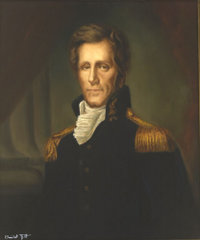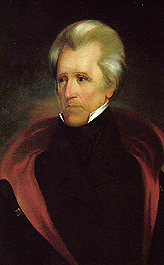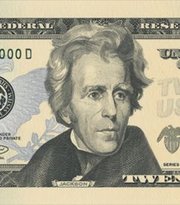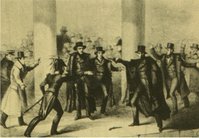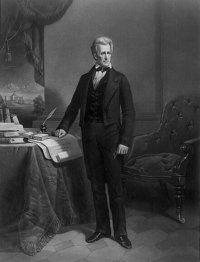Andrew Jackson
From Wikipedia, the free encyclopedia.
| Term of office | March 4, 1829 – March 3, 1837 |
| Preceded by | John Quincy Adams |
| Succeeded by | Martin Van Buren |
| Date of birth | March 15, 1767 |
| Place of birth | Waxhaws area of South Carolina |
| Spouse | Widowed Rachel Donelson Robards Jackson (niece Emily Donelson Jackson and daughter-in-law Sarah Yorke Jackson were first ladies) |
| Political party | Democrat |
Andrew Jackson (March 15, 1767 – June 8, 1845), one of the founders of the Democratic Party, was the seventh President of the United States, serving from 1829 to 1837. Until his election, every President had either been from Massachusetts or a member of the Virginia plantation elite. Jackson was nicknamed "Old Hickory" and (by American Indians) "Sharp Knife". He was the first president who had lived on the American frontier, and thus the first not primarily associated with one of the original thirteen colonies. Jackson became the symbol of an era in American history—known as the "Age of Jackson" or the "Jacksonian Era"—an era traditionally seen as dominating the years between the War of 1812 and the Civil War. A number of cities are named after him, notably Jacksonville, Florida and Jackson, Mississippi.
Contents |
Early life and military career
Jackson was born in a backwoods settlement to Scots-Irish immigrants in the Waxhaws area in the Carolinas, on March 15, 1767. Both North Carolina and South Carolina have claimed him as a "native son." Jackson himself always stated that he was born in South Carolina. He received a sporadic education. At age thirteen, he joined the Continental Army as a courier. He was captured and imprisoned by the British during the American Revolutionary War. Jackson was the last U.S. President to have been a veteran of the American Revolution, and the only President to have been a prisoner of war. The war took the lives of Jackson's entire immediate family.
During the Revolution, after the surrender to the British at Charleston, Jackson was taken as a prisoner to Camden, and nearly starved. When Jackson refused to clean the boots of a British officer, the irate redcoat slashed at Jackson, giving him scars on his left hand and head, as well as an intense hatred for the British. In addition, two of Jackson's brothers and his mother -- his entire remaining family -- died from war-time hardships that Jackson also blamed upon the British. This anglophobia would help to inspire a distrust and dislike of Eastern "aristocrats", whom Jackson felt were too inclined to favor and emulate their former colonial "masters". Jackson admired Napoleon Bonaparte, for his willingness to contest British military supremacy.
Jackson came to Tennessee by 1787, having barely read law, but finding that enough to become a young lawyer on the frontier. Since he was not from a distinguished family, he had to make his career by his own merits; and soon he began to prosper in the rough-and-tumble world of frontier law. Most of the actions grew out of disputed land-claims, or from assaults and battery. His courtroom demeanor was of his time. In 1795, he fought a duel with an opposing counsel over a courtroom argument. He was elected as Tennessee's first Congressman, upon statehood in the late 1790's, and quickly became a U.S. Senator in 1797, but quit within a year. In 1798, he was appointed Judge on the Supreme Court of Tennessee. [1]
Creek War and War of 1812
Jackson became a colonel in the Tennessee militia, which he had led since 1801, the beginning of his military career. In 1813, after a massacre of 400 men, women and children at Fort Mims (in what is now Alabama) by Northern Creek Band chieftain Peter McQueen, Jackson commanded in the campaign against the Northern Creek Indians of Alabama and Georgia, also known as the "Red Sticks". Creek leaders such as William Weatherford (Red Eagle), Peter McQueen, and Menawa, who had been allies of the British during the War of 1812, violently clashed with other chiefs of the Creek Nation over white encroachment on Creek lands, and the "civilizing" programs administered by U.S. Indian Agent Benjamin Hawkins. In the Creek War, a theatre of the War of 1812, Jackson defeated the Red Stick Creeks at the Battle of Horseshoe Bend, aided by allies from the Southern Creek Indian Band, who had requested Jackson's aid in putting down what they considered to be the "rebellious" Red Sticks, and some Cherokee Indians, who also sided with the Americans. Although 800 Northern Creek Band "Red Sticks" Indians were killed in the battle, Jackson spared Weatherford's life from any acts of vengence. Sam Houston and David Crockett, later to become famous themselves in Texas, served under Jackson at this time. Following the victory, Jackson imposed the Treaty of Ft. Jackson upon both his Northern Creek enemy and Southern Creek allies, wresting 20 million acres (81,000 km²) from all Creeks, for white settlement.
Jackson's service in the War of 1812 was conspicuous for its bravery and success. He was a strict officer, but was popular with his troops, and was said to have been "tough as old hickory" wood on the battlefield, which gave him his nickname. The war, and particularly his command at the Battle of New Orleans on January 8, 1815, made his national reputation; and he advanced in rank to Major General. In the battle, Jackson opposed 12,000 of the Duke of Wellington's finest troops (which had been victorious against Napoleon at the Battle of Waterloo), led by the Duke's brother-in-law Edward Pakenham; with only 6,000 of Jackson's own. The British had over 2,000 casualties to Jackson's 71 killed, wounded or missing during the battle. [2]
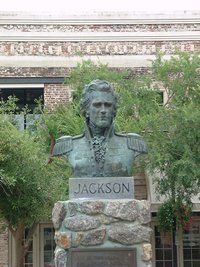
First Seminole War
Jackson saw military service again in what would become known as the First Seminole War, when he was requested by James Monroe in December, 1817 [3] to lead a campaign in Georgia against the Seminole and Creek Indians, and to prevent Spanish Florida from becoming a "refuge for runaway slaves". It was later said that Jackson exceeded his orders in Florida actions, but Monroe and the public wanted Florida. Before going, Jackson wrote to Monroe, "Let it be signified to me through any channel (say Mr. John Rhea [a mutual confidant]) that the possession of the Floridas would be desirable to the United States, and in sixty days it will be accomplished." Monroe gave Jackson orders that were purposely ambiguous, sufficient for international denials.
Jackson's Tennessee volunteers were attacked by Seminoles, but this left their villages vulnerable, and Jackson burned them and their crops. In his investigation, he found letters that indicated that the Spanish and British were "secretly" assisting the Indians. Jackson believed that the United States would not be "secure" as long as Spain and Great Britain encouraged American Indians to fight, and argued that his actions were undertaken in "self defense". Jackson captured Pensacola with little more than some warning shots, and deposed the Spanish governor. He captured, tried, and executed two British subjects who had been supplying and advising the Indians. Jackson's action also struck fear into the Seminole tribes, as word of his "ruthlessness in battle" spread.
This also created an international incident, and many in the Monroe administration called for Jackson to be censured. However, Jackson's actions were defended by Secretary of State John Quincy Adams. When the Spanish minister demanded a "suitable punishment" for Jackson, Adams wrote back "Spain must immediately [decide] either to place a force in Florida adequate at once to the protection of her territory, ... or cede to the United States a province, of which she retains nothing but the nominal possession, but which is, in fact, ... a post of annoyance to them." Adams used Jackson's conquest, and Spain's own "weaknesses", to convince the Spanish (in the Adams-Onís Treaty) to cede Florida to the United States. Jackson was subsequently appointed territorial governor there.
Jackson as President
During his first run for the Presidency in 1824, Jackson received a plurality of both the popular and electoral votes. Since no candidate received a majority, the election was thrown into the House of Representatives, which chose John Quincy Adams instead. The election was considered dirty and, by many, "stolen." Jackson himself favored reform of the electoral system afterwards, including abolishing the Electoral College. Jackson's defeat burnished his political credentials, however; since many voters believed the "man of the people" had been robbed by the "corrupt aristocrats of the East". Jackson won a solid victory in his second attempt in 1828, as the first nominee of the Democratic Party.
Jackson was the first U.S. president to come from outside the original Revolutionary circle. Washington, Adams, Jefferson and Madison had been notable figures in the War of Independence, and in the formation of the U.S. Constitution. James Monroe had fought in the Revolutionary War. John Quincy Adams was the son of John Adams. Jackson's election represented a significant break from that past.
He was also the first president from a state west of the Appalachian Mountains, and the first president to be elected from a state in which he was not born. (Though born in the Carolinas, Jackson spent virtually all his adult life in Tennessee.) This was the first election in which many states allowed people without land to vote, and they voted for Jackson.
Jackson is remembered for introducing the "spoils system", or "patronage", to American politics (although it had of course been practiced less obviously, before). Upon Jackson's election as President, a sizable number of people holding federal offices found that they had suddenly been replaced by supporters of Jackson, who had worked to ensure his election. Jackson saw this system as "promoting the growth of democracy," because more people were involved in politics. This practice has endured in political circles in the United States, ever since. Additionally, Jackson pressured states to lower voting requirements to "further the expansion of democracy".
Opposition to the National Bank
As president, Jackson worked to dismantle the Second Bank of the United States. The original Bank of the United States had been introduced in 1791 by Alexander Hamilton, as a way of organizing the federal government's finances. This first Bank had lapsed in 1811. It was followed by the second Bank, authorized by James Madison in 1816, to "alleviate the economic problems caused by the War of 1812". Both Banks were instrumental in the growth of the U.S. economy; but Jackson opposed the concept, on ideological grounds. In Jackson's opinion, the Bank needed to be abolished because:
- it was unconstitutional;
- it concentrated an excessive amount of the nation's financial strength into one single institution;
- it exposed the government to control by "foreign interests";
- it exercised too much control over members of the U.S. Congress;
- it favored Northeastern states over Southern and Western (now Mid-western) states.
Jackson's opposition to the Bank manifested as a strong personal dislike for its president, Nicholas Biddle.
Jackson followed Jefferson as a supporter of the ideal of an "agricultural republic", and felt the Bank improved the fortunes of an "elite circle" of commercial and industrial entrepreneurs, at the expense of farmers and laborers. After a titanic struggle, Jackson succeeded in destroying the Bank, by vetoing its 1832 re-charter by Congress, and by withdrawing U.S. funds in 1833. It was a "Pyrrhic victory", however; as the Bank's money-lending functions were taken over by the legions of local and state banks that sprang up along with the expansion of credits and "speculation", and the commercial progress of the nation's economy was noticeably dented. The United States Senate censured Jackson on March 27, 1834 for his actions in "defunding" the Bank of the United States.
Nullification crisis
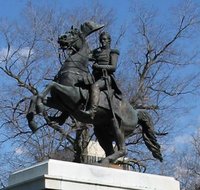
Another notable crisis during Jackson's period of office was the "nullification crisis" (or "secession crisis"), of 1828–1832, which merged issues of sectional strife with disagreements over trade tariffs. High tariffs (the "Tariff of Abominations") on imports of common goods were seen by many in Southern states as unfairly benefiting Northern merchants and industrial entrepreneurs, at the expense of those who had to buy the goods subject to the tariffs; mostly Southern farmers. The issue came to a head when Vice President John C. Calhoun, in the South Carolina Exposition and Protest of 1828, supported the claim of his home state, South Carolina, that it had the right to "nullify"—declare illegal—the tariff legislation of 1828, and more generally the right of a state to nullify laws which went against its interests. Although Jackson sympathized with the Southern interpretation of the tariff debate, he was also a strong supporter of federalism (in the sense of supporting a strong union, with considerable powers for the central government) and attempted to face Calhoun down over the issue; which developed into a bitter rivalry between the two men. Particularly famous was an incident at the April 13, 1829 Jefferson Day dinner, involving after-dinner toasts. Jackson rose first and voice booming, and glaring at Calhoun, yelled out "Our federal Union: IT MUST BE PRESERVED!", a clear challenge to Calhoun. Calhoun glared at Jackson and yelled out, his voice trembling, but booming as well, "The Union: NEXT TO OUR LIBERTY, MOST DEAR!", an astonishingly quick-witted riposte.
In response to South Carolina's threat, Congress passed a "Force Bill", and Jackson vowed to send troops to South Carolina in order to enforce the laws. On December 10, he issued a resounding proclamation against the "nullifiers", stating: "I consider...the power to annul a law of the United States, assumed by one State, incompatible with the existance of the Union, contradicted expressly by the letter of the Constitution, unauthorized by its spirit, inconsistent with every principle on which it was founded, and destructive of the great object for which it was formed." South Carolina, the president declared, stood on "the brink of insurrection and treason," and he appealed to the people of the state to reassert their allegiance to that Union for which their ancestors had fought. Jackson also denied the right of secession: "The Constitution...forms a government not a league...To say that any State may at pleasure secede from the Union is to say that the United States is not a nation."
The crisis was resolved in 1833 with a compromise settlement orchestrated by Whig politician Henry Clay and adopted by a South Carolina convention. The settlement substantially lowering the tariffs and hinted that the central government considered itself "weak" in dealing with determined opposition by an individual state. To enforce this view, the convention proudly but pointlessly declared the federal Force Bill nullified, even though the bill was only meaningful with respect to the tariff nullification. Thus, the South Carolina legislature both averted major conflict with the federal government, and reaffirmed Calhoun's beloved doctrine of nullification.
Indian Removal
Jackson was a strong supporter of the policy of "Indian Removal", and he signed the Indian Removal Act into law in 1830. The Removal Act did not order the removal of any American Indians, but it authorized the President to negotiate treaties that would exchange tribal land in the east, for western lands that had been acquired in the Louisiana Purchase. According to biographer Robert V. Remini, Jackson favored re-locating Native American tribes outside existing states, primarily for "national security" reasons, since most American Indians had sided with the British in the Revolution and the War of 1812.
The Removal Act was especially popular in the South, where population growth and the discovery of gold on Cherokee land had increased pressure on tribal lands. The state of Georgia became involved in a contentious jurisdictional dispute with the Cherokees, culminating in the 1832 Supreme Court decision (Worcester v. Georgia) that ruled that Georgia could not impose its laws upon Cherokee tribal lands.
However, Jackson had no intention of protecting the Cherokees from the state of Georgia, although the famously defiant quote attributed to him ("John Marshall has made his decision, now let him enforce it!") was probably never uttered by Jackson. Realizing that removal under Jackson was inevitable, a faction of Cherokees led by Major Ridge negotiated the Treaty of New Echota with Jackson's administration, a document of dubious legality, that was rejected by most Cherokees. However, the terms of the treaty were strictly enforced by Jackson's successor, Martin van Buren, which resulted in the deaths of thousands of Cherokees along the "Trail of Tears".
Indian removal was used against the other four "civilized tribes" as well. The Creeks, for example, already feeling betrayed after the Battle of Horseshoe Bend, were relocated to Fort Gibson in the "Indian Territories" during this period, after Southern Creek Band Leader William McIntosh agreed to cede most of Georgia to the United States in the Treaty of Indian Springs, resulting in McIntosh's assassination by Red Stick leader Menawa. Despite the treaty's nullification one year later by Congress, it was nevertheless enforced by Georgia Governor George Troup.
Assassination attempt
On January 30, 1835 an unsuccessful assassination attempt against Jackson occurred in the United States Capitol. This was the first assassination attempt against an American President. While Jackson was leaving a funeral for South Carolina congressman Warren R. Davis, a mentally-ill unemployed house painter, Richard Lawrence, came up to Jackson and fired a pistol at point-blank range. The pistol mis-fired, and before anyone could react, the assassin pulled another pistol which, amazingly, also misfired. Instead of running or taking cover, the 67-year-old president proceeded to physically confront Lawrence with his cane. The print (shown right) made 20 years later, became quite popular because it shows the president boldly confronting his attacker. The would-be assassin, who claimed Jackson had prevented him from taking his rightful claim to the British throne, was found "not guilty, by reason of insanity", and was committed to an asylum. Supporters of Jackson later accused the Whig Party of a conspiracy, but the accusation was never substantiated.
Major presidential acts
- Maysville Road Veto
- Signed Indian Removal Act of 1830
- Vetoed renewal of Second Bank of the United States (1832)
- Signed Force Bill of 1833
- Executive Order: Specie Circular (1836)
Cabinet
| OFFICE | NAME | TERM |
| President | Andrew Jackson | 1829–1837 |
| Vice President | John C. Calhoun | 1829–1832 |
| Martin Van Buren | 1833–1837 | |
| Secretary of State | Martin Van Buren | 1829–1831 |
| Edward Livingston | 1831–1833 | |
| Louis McLane | 1833–1834 | |
| John Forsyth | 1834–1837 | |
| Secretary of the Treasury | Samuel Ingham | 1829–1831 |
| Louis McLane | 1831–1833 | |
| William Duane | 1833 | |
| Roger B. Taney | 1833–1834 | |
| Levi Woodbury | 1834–1837 | |
| Secretary of War | John H. Eaton | 1829–1831 |
| Lewis Cass | 1831–1836 | |
| Attorney General | John M. Berrien | 1829–1831 |
| Roger B. Taney | 1831–1833 | |
| Benjamin F. Butler | 1833–1837 | |
| Postmaster General | William Barry | 1829–1835 |
| Amos Kendall | 1835–1837 | |
| Secretary of the Navy | John Branch | 1829–1831 |
| Levi Woodbury | 1831–1834 | |
| Mahlon Dickerson | 1834–1837 | |
Supreme Court appointments
Supreme Court cases during his presidency
- Cherokee Nation vs. Georgia, 1831
- Worcester v. Georgia, 1832
- Charles River Bridge v. Warren Bridge, 1837
States admitted to the Union
Family and later life
Jackson's wife, Rachel, died of a heart attack just 2 months prior to his taking office as President. She had supposedly divorced her first husband, Col. Lewis Robards; but there were "questions" about the legality of the divorce. Jackson deeply resented attacks on his wife's honor; he killed Charles Dickinson in a duel over a horse-racing debt and an insult to his wife on May 30, 1806. Jackson was also injured during the duel, and the bullet was so close to his heart that it could never be safely removed. It caused him considerable pain for the rest of his life. Jackson blamed John Quincy Adams for Rachel's death, because of the marital scandal being brought up in the election of 1828. He felt that this had hastened her death, and never forgave Adams.
Jackson had two adopted sons, Andrew Jackson Donelson. and Lyncoya, a Creek Indian orphan adopted by Jackson after the Creek War. Lyncoya died in 1828 at age 16, probably from pneumonia or tuberculosis.
Jackson remained influential in both national and state politics after retiring to "The Hermitage", his Nashville home, in 1837. Though a slave-holder, Jackson was a firm advocate of the federal union of the states, and declined to give any support to talk of secession. He died at the Hermitage on June 8, 1845 at the age of 78, of chronic tuberculosis, "dropsy" and heart failure. His last words were: "Oh, do not cry. Be good children, and we shall all meet in Heaven."
In his will, Jackson left his entire estate to his adopted son, Andrew Jackson Jr., except for specifically enumerated items that were left to various other friends and family members. Jackson left several slaves to his daughter-in-law, and grandchildren. Jackson left a sword to his grandson, with the injunction, "that he will always use it in defence of our glorious Union."
Physical characteristics & Health
Jackson was a lean figure standing at 6 feet, 1 inch (1.85 m) tall, and weighing between 130 and 140 pounds (64 kg) on average. Jackson also had an unruly shock of red hair, which had completely grayed by the time he became president at age 61, in 1829. He had a pair of the most penetrating deep blue eyes. Jackson was one of our more sickly presidents, suffering from chronic headaches, abdominal pains, and a hacking cough that often brought up blood and sometimes even made his whole body shake. Also, Jackson caught many colds and fevers that made his aches and pains and hacking cough even worse. Jackson was also very nearsighted and wore glasses for most of his presidency. Many people thought that Jackson would die in office because his health was so bad. Of course, he proved them wrong. However, by the time he left office in 1837, Jackson's health had grown much worse, and many people and even his doctors thought that Jackson would undoubtedly not be able to survive the trip back home to Nashville. But, Andrew proved them wrong yet again. He survived the grueling trip home and enjoyed 8 more happy and joyful years of retirement before he finally passed away at 6:00 p.m. on Sunday June 8, 1845 at the ripe old age of 78 years, 2 months, 3 weeks, and 3 days.
Movie and biography
The story of Andrew and Rachel Jackson's life together was told in Irving Stone's best-selling 1951 biographical novel The President's Lady, which was made into the 1953 movie of the same title, starring Susan Hayward, Charlton Heston, John McIntire, and Carl Betz and directed by Henry Levin. The relationship between the two was also the basis of a successful documentary by the Public Broadcasting System, called Rachel and Andrew Jackson: A Love Story.
References
- Henry Adams, History of the United States of America During the Administrations of James Madison (Library Classics of the United State, Inc. 1986), ISBN 0940450356
- Brustein, Andrew. The Passions of Andrew Jackson. New York: Knopf, 2003. ISBN 0375414282
- James, Marquis. The Life of Andrew Jackson New York: Bobbs-Merrill, 1938. Combines two books: The Border Captain and Andrew Jackson: Portrait of a President; winner of the Pulitzer Prize for Biography.
- Robert V. Remini, The Life of Andrew Jackson. Abridgment of Remini's 3-volume biography, originally published New York: Harper, 1998 (ISBN 0060159049); reprinted 2001 (ISBN 0060937351).
- Robert V. Remini, Andrew Jackson and his Indian Wars. New York: Viking, 2001. ISBN 0670910252.
- Schlesinger, Arthur M. Jr. The Age of Jackson. Originally published Boston: Little, Brown, 1945, often reprinted. ISBN 0316773441. Winner of the Pulitzer Prize for History.
- Wallace, Anthony F.C. The Long, Bitter Trail: Andrew Jackson and the Indians. New York: Hill & Wang, 1993. ISBN 0809015528 (paperback), ISBN 0809066319 (hardback).
See also
- United States dollar — Jackson's portrait appears on the $20 bill. He has appeared on $5, $10, $50, and $10,000 bills in the past, as well as a Confederate $1,000.
- Blackjack United States postage stamp
- U.S. presidential election, 1824
- U.S. presidential election, 1828
- U.S. presidential election, 1832
- List of places named for Andrew Jackson
- The Hermitage, Andrew Jackson's home, now a tourist destination
External links
- Andrew Jackson on the Web (resource directory)
- Critical Resources: Andrew Jackson and Indian Removal
- A genealogical profile of the President
- Jackson's medical history
- Portraits of Jackson on bank notes
- PBS documentary on Rachel & Andrew's life together
- Andrew Jackson letters to Richard K. Call
Inaugural addresses
State of the Union addresses
- First State of the Union of Andrew Jackson
- Second State of the Union of Andrew Jackson
- Third State of the Union of Andrew Jackson
- Fourth State of the Union of Andrew Jackson
- Fifth State of the Union of Andrew Jackson
- Sixth State of the Union of Andrew Jackson
- Seventh State of the Union of Andrew Jackson
- Final State of the Union of Andrew Jackson
| Preceded by: (none) |
U.S. Congressman from Tennessee 1796 – 1797 |
Succeeded by: William Claiborne |
| Preceded by: William Cocke |
U.S. Senator (Tennessee) 1797 – 1798 |
Succeeded by: Daniel Smith |
| Preceded by: (none) |
Military Governor of Florida 1821 |
Succeeded by: William P. Duval Territorial Governor |
| Preceded by: John Williams |
U.S. Senator (Tennessee) 1823 – 1825 |
Succeeded by: Hugh Lawson White |
| Preceded by: James Monroe |
Republican Party presidential candidate 1824 (lost)(a) |
Succeeded by: (none) |
| Preceded by: (none) |
Democratic Party presidential candidate 1828 (won), 1832 (won) |
Succeeded by: Martin Van Buren |
| Preceded by: John Quincy Adams |
President of the United States March 4, 1829 – March 3, 1837 |
Succeeded by: Martin Van Buren |
| Presidents of the United States of America | 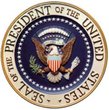 |
|---|---|
| Washington | J Adams | Jefferson | Madison | Monroe | JQ Adams | Jackson | Van Buren | W Harrison | Tyler | Polk | Taylor | Fillmore | Pierce | Buchanan | Lincoln | A Johnson | Grant | Hayes | Garfield | Arthur | Cleveland | B Harrison | Cleveland | McKinley | T Roosevelt | Taft | Wilson | Harding | Coolidge | Hoover | F Roosevelt | Truman | Eisenhower | Kennedy | L Johnson | Nixon | Ford | Carter | Reagan | GHW Bush | Clinton | GW Bush |
| United States Democratic Party Presidential Nominees |  |
|---|---|
| Jackson | Van Buren | Polk | Cass | Pierce | Buchanan | Douglas/Breckinridge(SD) | McClellan | Seymour | Greeley | Tilden | Hancock | Cleveland | Bryan | Parker | Bryan | Wilson | Cox | Davis | Smith | Roosevelt | Truman | Stevenson | Kennedy | Johnson | Humphrey | McGovern | Carter | Mondale | Dukakis | Clinton | Gore | Kerry |
